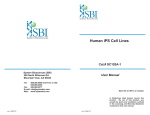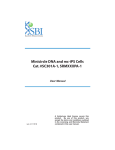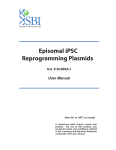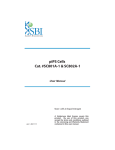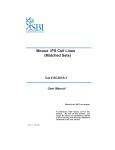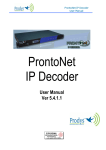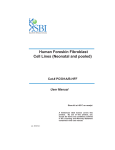Download PSGro Media Protocol
Transcript
PSGro® hESC/iPSC Growth Medium Catalog number: SC500M-1 Product Description PSGro® hESC/iPSC Growth Medium is a fully defined, serum- and feeder-free medium, which is developed for maintenance and expansion of human embryonic stem cells and human induced pluripotent stem cells. PSGro® medium has been extensively tested and is proven to support the growth of pluripotent stem cells for at least 30 passages while retaining pluripotency marker expression, normal karyotype, and the ability to differentiate into all three germ line lineages. PSGro® hESC/iPSC Growth Medium is chemically defined and is xeno-free, thus eliminating concerns of lot-to-lot variations. Content and Storage of the Product PSGro® (Catalog No. SC500M-1) contains two components: Size Storage Shelf Life PSGro® Basal Medium 1 x 450mL 2 to 8°C. Protect from light 6 months PSGro® 10X Supplement 1 x 50mL -20°C. Protect from light 6 months Recommended precautions Prepare a frozen stock of the cells in medium prior to transfer into this product. Storage and handling Supplement is supplied as a frozen sample. Thaw supplement prior to use, aliquot to in desired volumes, and store them immediately in -20°C. Avoid multiple freeze thaw cycles of supplement. Thawed Supplement must be stored at 2 to 8°C. PSGro® complete medium is stable for up to one week with proper storage. Additional reagents required for human ES/iPS cell culture Matrigel (BD, cat. no. 354277) Collagenase IV (Invitrogen, cat. no. 17104) or Accutase (Millipore, cat. no. SCR005) ROCK inhibitor (System Biosciences, cat. no. ZRD-Y2-10) DPBS 70% Ethanol or Isopropanol Preparation of PSGro® feeder-free medium 1. Thaw PSGro® Supplement at room temperature or overnight at 4°C. 2. Add 50 mL of thawed Supplement to 450 mL Basal Medium for a total volume of 500 mL aseptically. Mix well. Filter through a 0.2 μm, low-protein binding filter, if desired. 3. Aliquot into appropriate amount according to usage and store the aliquots at 4°C. Coating plates with Matrigel Matrigel (cat. no. 354277, BD) should be aliquoted and stored at -80°C for long term use. 1. Thaw Matrigel on ice until liquid. Dilute Matrigel 1:50 with pre-chilled KO DMEM/F12. 2. Immediately use the diluted Matrigel solution to coat tissue culture-treated plates. For a 6-well plate, use 1 mL of diluted matrigel solution per well, and swirl the plate to spread the Matrigel solution evenly across the surface. 3. Let the plate stand for 1 h at 37°C or overnight at 4°C. If the plate has been stored at 4°C, allow the plate to incubate at 37°C for 30 minutes before removing the Matrigel solution. 1 Thawing cryopreserved hiPSCs 1. Quickly thaw the hiPSCs in a 37°C waterbath by gently shaking the cryovial continuously until half thawed. Remove the cryovial from the waterbath and spray with 70% ethanol to sterilize. 2. Transfer the contents of the cryovial to a 15 mL conical tube. Add 5 mL warm PSGro® medium dropwise to the tube, gently mixing as the medium is added. 3. Centrifuge cells at 200 x g for 5 minutes at room temperature. 4. While centrifuging, remove the Matrigel solution from a coated tissue culture 6‐well plate. Add 1 mL of warm PSGro® medium containing 10 µM ROCK inhibitor to one well of 6‐well plate. 5. After centrifugation, aspirate the medium from 15 mL tube. Gently resuspend the cell pellet in 1 mL PSGro® medium with 10 µM ROCK inhibitor, taking care to maintain the cells as small aggregates. 6. Transfer the medium containing the cell aggregates to the Matrigel coated 6‐well plate. 7. Place the plate into the 37°C incubator and move the plate in quick side to side, forward to back motions to evenly distribute the clumps within the wells. Culture the cells at 37°C, with 5% CO2 and 95% humidity. 8. Change medium daily. Check for undifferentiated colonies that are ready to be passaged approximately 7‐10 days after thawing. Passaging hiPSCs grown under feeder-free condition 1. Look under microscope to identify regions of differentiation. Mark the differentiated colonies using lens marker on the bottom of the plate. 2. Remove regions of differentiation by scraping with a pipette tip or by aspiration. 3. Aspirate medium from the hiPSC culture and rinse with DPBS (2 mL/well). 4. Add 0.5 mL per well of Accutase (cat. no. SCR005, Millipore, diluted 1:1 with DPBS before use). Let it stand at room temperature for 1‐2 minutes. 5. Remove Accutase, and gently rinse each well 2 ‐ 3 times with 2 mL of KO‐DMEM/F‐12 per well to dilute away remaining enzymes. 6. Add 2 mL/well PSGro® medium and scrape colonies off with a cell scraper. 7. Transfer the detached cell aggregates to a 15 mL conical tube and rinse the well with an additional 2 mL PSGro® medium to collect any remaining aggregates. Add the rinse to the 15 mL tube. 8. Centrifuge the 15 mL tube containing the aggregates at 200 x g for 5 minutes at room temperature. 9. Aspirate the supernatant. Resuspend pellet in PSGro® medium containing 10 µM ROCK inhibitor by gently pipetting and ensure that cells are maintained as aggregates. 10. Plate the hiPSC aggregates with PSGro® medium onto a new plate coated with Matrigel. (Remove Matrigel solution before plating). If the colonies are at an optimal density, the cells can be split every 5 ‐ 7 days using 1:6 to 1:10 splits. 12. Place the plate into the 37°C incubator and move the plate in quick side to side, forward to back motions to evenly distribute the clumps within the wells. Culture the cells at 37°C, with 5% CO2 and 95% humidity. 13. Change medium daily. Cryopreserving hiPSCs 1. Prepare freezing medium which contains 90% FBS, 10% DMSO and 10 µM ROCK inhibitor. 2. Perform steps 1‐8 from Passaging hiPSCs grown under feeder‐free condition 3. Gently aspirate the supernatant taking care to keep the cell pellet intact. 4. Gently resuspend the pellet in freezing medium, taking care to leave the clumps larger than would normally be done for passaging. 5. Transfer 1 mL of clumps in freezing medium into each labeled cryovial. 6. Place vials into an isopropanol freezing container and place the container at ‐80°C overnight. 7. Transfer to a liquid nitrogen tank the next day. Transferring hiPSCs from feeder-based culture into PSGro® medium 1. Aspirate the culture medium from the well. 2 2. Add 0.5 mL per well of Accutase (cat. no. SCR005, Millipore, diluted 1:1 with DPBS before use). Let it stand at room temperature for 1‐2 minutes. Note: Incubation times will vary between cell lines and colony sizes. Check the culture frequently. Do not over‐incubate the culture, as hiPSCs are sensitive to enzymatic stress. 3. Remove Accutase, and gently rinse each well 2 ‐ 3 times with 2 mL of KO‐DMEM/F‐12 per well to dilute away remaining enzymes, and wash away most of the feeder cells. 4. Add 2 mL of PSGro® medium, gently scrape and wash the colonies off with a 5‐mL pipet. 5. Transfer the contents to a 15 ml tube. 6. Use another 2 ml of medium to wash the well. Transfer the contents into the same15 ml tube. 7. Centrifuge at 200 x g for 5 minutes at room temperature. 8. While the cells are spinning, aspirate the solution from a pre‐warmed 6‐well Matrigel‐coated plate. 9. Add 1 ml of PSGro® medium to each well of the plate. 10. Carefully aspirate the supernatant from the 15 ml tube without disturbing the cell pellet. Loosen the cell pellet by tapping the bottom of the tube. 11. Gently add 6 ml of PSGro® medium. Mix the contents by gently pipetting up and down with a 5 ml pipet. 12. Add 1 ml of the cell suspension into each well of the plate. 13. Place the plate into the 37°C incubator and move the plate from side to side (in both directions) several times to evenly distribute the cells. 14. Incubate overnight at 37°C and 5% CO2. 15. Change the medium daily with 2 mL of fresh PSGro® medium until the hiPSC colonies are big enough to passage (about 5 days). Note For research use only. References 1. Takahashi K. et al. 2007. Cell. 131: 861–72. 2. Park, IH et al. 2008. Nature. 451:141–6. 3. Nakagawa, M et al. 2008. Nature Biotechnology. 26: 101–106. 4. Okita, K, et al. 2007. Nature. 448:313–7 5. Thomson, J.A. et al. 1998.Science 282: 1145. 6. Ludwig, T.E. et al. 2006. Nature Biotechnology 24: 185–7. 7. Hoffman, L.M. et al. 2005. Nature Biotechnology 23: 699–708. 3 Technical Support For more information about SBI products and to download manuals in PDF format, please visit our web site: http://www.systembio.com For additional information or technical assistance, please call or email us at: System Biosciences (SBI) 265 North Whisman Road. Mountain View, CA 94043 Phone: (650) 968‐2200 (888) 266‐5066 (Toll Free) Fax: (650) 968‐2277 E‐mail: General Information: [email protected] Technical Support: [email protected] Ordering Information: [email protected] Licensing and Warranty Statement Limited Use License Use of PSGro® hESC/iPSC Growth Medium (i.e., the “Product”) is subject to the following terms and conditions. If the terms and conditions are not acceptable, return all components of the Product to System Biosciences (SBI) within 7 calendar days. Purchase and use of any part of the Product constitutes acceptance of the above terms. Purchase of the product does not grant any rights or license for use other than those explicitly listed in this Licensing and Warranty Statement. Use of the Product for any use other than described expressly herein may be covered by patents or subject to rights other than those mentioned. SBI disclaims any and all responsibility for injury or damage which may be caused by the failure of the buyer or any other person to use the Product in accordance with the terms and conditions outlined herein. SBI has pending patent applications related to the Product. For information concerning licenses for commercial use, contact SBI. Limited Warranty SBI warrants that the Product meets the specifications described in the accompanying Product Analysis Certificate. If it is proven to the satisfaction of SBI that the Product fails to meet these specifications, SBI will replace the Product or provide the purchaser with a refund. This limited warranty shall not extend to anyone other than the original purchaser of the Product. Notice of nonconforming products must be made to SBI within 30 days of receipt of the Product. SBI’s liability is expressly limited to replacement of Product or a refund limited to the actual purchase price. SBI’s liability does not extend to any damages arising from use or improper use of the Product, or losses associated with the use of additional materials or reagents. This limited warranty is the sole and exclusive warranty. SBI does not provide any other warranties of any kind, expressed or implied, including the merchantability or fitness of the Product for a particular purpose. SBI is committed to providing our customers with high-quality products. If you should have any questions or concerns about any SBI products, please contact us at (888) 266-5066. © 2012 System Biosciences (SBI). 4




